service schedule CADILLAC ESCALADE 2010 3.G Owners Manual
[x] Cancel search | Manufacturer: CADILLAC, Model Year: 2010, Model line: ESCALADE, Model: CADILLAC ESCALADE 2010 3.GPages: 616, PDF Size: 39.41 MB
Page 2 of 616

2010 Cadillac Escalade/Escalade ESV Owner ManualM
Navigation System. . . . . . . . . . . . . . . . . . . . . . . . . . . . . . . 5-1Overview . . . . . . . . . . . . . . . . . . . . . . . . . . . . . . . . . . . . . . . . . 5-2Features and Controls . . . . . . . . . . . . . . . . . . . . . . . . . . 5-12Navigation Audio System . . . . . . . . . . . . . . . . . . . . . . . 5-60Voice Recognition . . . . . . . . . . . . . . . . . . . . . . . . . . . . . . . 5-86
Driving Your Vehicle. . . . . . . . . . . . . . . . . . . . . . . . . . . . . . 6-1Your Driving, the Road, and the Vehicle . . . . . . . . . . 6-2Towing . . . . . . . . . . . . . . . . . . . . . . . . . . . . . . . . . . . . . . . . . . 6-38
Service and Appearance Care. . . . . . . . . . . . . . . . . . . 7-1Service . . . . . . . . . . . . . . . . . . . . . . . . . . . . . . . . . . . . . . . . . . . 7-4Fuel . . . . . . . . . . . . . . . . . . . . . . . . . . . . . . . . . . . . . . . . . . . . . . 7-7Checking Things Under the Hood . . . . . . . . . . . . . . . 7-14All-Wheel Drive . . . . . . . . . . . . . . . . . . . . . . . . . . . . . . . . . 7-49Rear Axle . . . . . . . . . . . . . . . . . . . . . . . . . . . . . . . . . . . . . . . 7-50Front Axle . . . . . . . . . . . . . . . . . . . . . . . . . . . . . . . . . . . . . . . 7-51
Headlamp Aiming . . . . . . . . . . . . . . . . . . . . . . . . . . . . . . . 7-52Bulb Replacement . . . . . . . . . . . . . . . . . . . . . . . . . . . . . . 7-54Windshield Wiper Blade Replacement . . . . . . . . . . . 7-57Tires . . . . . . . . . . . . . . . . . . . . . . . . . . . . . . . . . . . . . . . . . . . . 7-58Appearance Care . . . . . . . . . . . . . . . . . . . . . . . . . . . . . . . 7-98Vehicle Identification . . . . . . . . . . . . . . . . . . . . . . . . . . . 7-107Electrical System . . . . . . . . . . . . . . . . . . . . . . . . . . . . . . 7-108Capacities and Specifications . . . . . . . . . . . . . . . . . . 7-115
Maintenance Schedule. . . . . . . . . . . . . . . . . . . . . . . . . . . 8-1Maintenance Schedule . . . . . . . . . . . . . . . . . . . . . . . . . . . 8-2
Customer Assistance Information. . . . . . . . . . . . . . . 9-1Customer Assistance and Information . . . . . . . . . . . . 9-2Reporting Safety Defects . . . . . . . . . . . . . . . . . . . . . . . . 9-16Vehicle Data Recording and Privacy . . . . . . . . . . . . . 9-18
Index. . . . . . . . . . . . . . . . . . . . . . . . . . . . . . . . . . . . i-1
Page 123 of 616
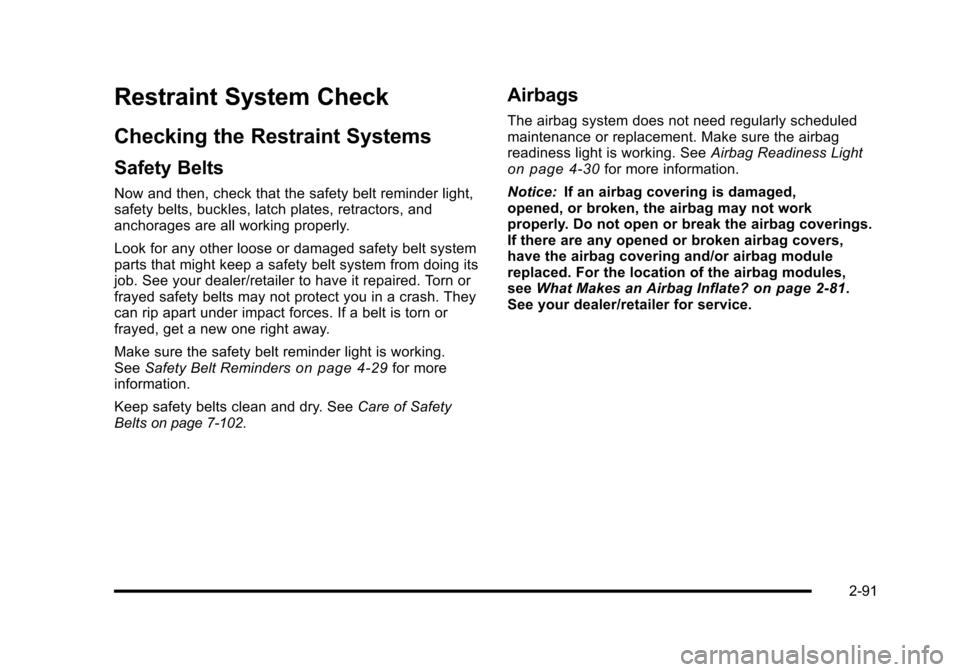
Restraint System Check
Checking the Restraint Systems
Safety Belts
Now and then, check that the safety belt reminder light,safety belts, buckles, latch plates, retractors, andanchorages are all working properly.
Look for any other loose or damaged safety belt systemparts that might keep a safety belt system from doing itsjob. See your dealer/retailer to have it repaired. Torn orfrayed safety belts may not protect you in a crash. Theycan rip apart under impact forces. If a belt is torn orfrayed, get a new one right away.
Make sure the safety belt reminder light is working.SeeSafety Belt Reminderson page 4!29for moreinformation.
Keep safety belts clean and dry. SeeCare of SafetyBeltson page 7!102.
Airbags
The airbag system does not need regularly scheduledmaintenance or replacement. Make sure the airbagreadiness light is working. SeeAirbag Readiness Lighton page 4!30for more information.
Notice:If an airbag covering is damaged,opened, or broken, the airbag may not workproperly. Do not open or break the airbag coverings.If there are any opened or broken airbag covers,have the airbag covering and/or airbag modulereplaced. For the location of the airbag modules,seeWhat Makes an Airbag Inflate?on page 2!81.See your dealer/retailer for service.
2-91
Page 230 of 616
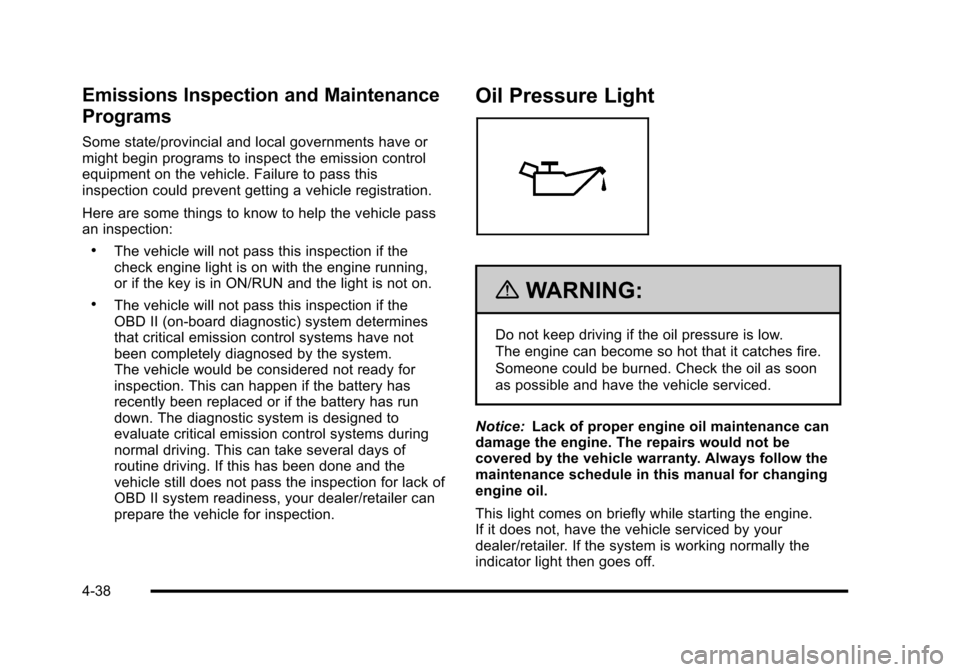
Emissions Inspection and Maintenance
Programs
Some state/provincial and local governments have ormight begin programs to inspect the emission controlequipment on the vehicle. Failure to pass thisinspection could prevent getting a vehicle registration.
Here are some things to know to help the vehicle passan inspection:
.The vehicle will not pass this inspection if thecheck engine light is on with the engine running,or if the key is in ON/RUN and the light is not on.
.The vehicle will not pass this inspection if theOBD II (on-board diagnostic) system determinesthat critical emission control systems have notbeen completely diagnosed by the system.The vehicle would be considered not ready forinspection. This can happen if the battery hasrecently been replaced or if the battery has rundown. The diagnostic system is designed toevaluate critical emission control systems duringnormal driving. This can take several days ofroutine driving. If this has been done and thevehicle still does not pass the inspection for lack ofOBD II system readiness, your dealer/retailer canprepare the vehicle for inspection.
Oil Pressure Light
{WARNING:
Do not keep driving if the oil pressure is low.
The engine can become so hot that it catches fire.
Someone could be burned. Check the oil as soon
as possible and have the vehicle serviced.
Notice:Lack of proper engine oil maintenance candamage the engine. The repairs would not becovered by the vehicle warranty. Always follow themaintenance schedule in this manual for changingengine oil.
This light comes on briefly while starting the engine.If it does not, have the vehicle serviced by yourdealer/retailer. If the system is working normally theindicator light then goes off.
4-38
Page 347 of 616

Traffic Options
Read the following Options descriptions to understandhow the XM NavTraffic™operates.
XM NavTraffic™(USA and Canada)
Vehicles with the navigation system have anXM NavTraffic™receiver. XM NavTraffic™is asubscription service provided via XM™Satellite Radio.XM NavTraffic™provides real-time traffic informationfully integrated to the navigation system to displaycurrent traffic conditions for a driver’s chosen route.XM NavTraffic™allows drivers to make the mostinformed, timesaving routing decisions.
If the Traffic touch screen button is pressed or if anattempt is made to turn on the traffic display in theNavigation Setup Menu without a subscription, aCaution screen displays indicating that XM traffic isnot activated.
Three types of traffic information for major roadways aredisplayed on the navigation system:
.Unscheduled traffic incident data, such asaccidents and disabled vehicles
.Scheduled traffic incident data, such as roadconstruction and road closures
.Traffic flow information (rate of speed data)
Traffic information is delivered to the vehicle bythe XM™Radio satellites. XM NavTraffic™makesit possible for the navigation system to providecontinuously updated traffic information personalizedfor a driver’s needs.
5-47
Page 414 of 616
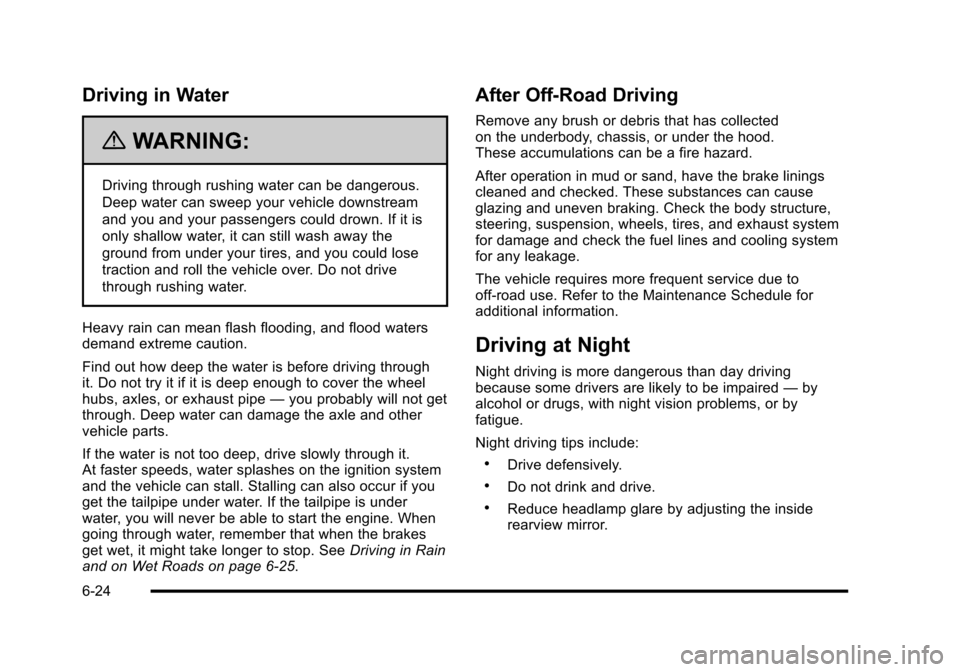
Driving in Water
{WARNING:
Driving through rushing water can be dangerous.
Deep water can sweep your vehicle downstream
and you and your passengers could drown. If it is
only shallow water, it can still wash away the
ground from under your tires, and you could lose
traction and roll the vehicle over. Do not drive
through rushing water.
Heavy rain can mean flash flooding, and flood watersdemand extreme caution.
Find out how deep the water is before driving throughit. Do not try it if it is deep enough to cover the wheelhubs, axles, or exhaust pipe—you probably will not getthrough. Deep water can damage the axle and othervehicle parts.
If the water is not too deep, drive slowly through it.At faster speeds, water splashes on the ignition systemand the vehicle can stall. Stalling can also occur if youget the tailpipe under water. If the tailpipe is underwater, you will never be able to start the engine. Whengoing through water, remember that when the brakesget wet, it might take longer to stop. SeeDriving in Rainand on Wet Roads on page 6!25.
After Off-Road Driving
Remove any brush or debris that has collectedon the underbody, chassis, or under the hood.These accumulations can be a fire hazard.
After operation in mud or sand, have the brake liningscleaned and checked. These substances can causeglazing and uneven braking. Check the body structure,steering, suspension, wheels, tires, and exhaust systemfor damage and check the fuel lines and cooling systemfor any leakage.
The vehicle requires more frequent service due tooff-road use. Refer to the Maintenance Schedule foradditional information.
Driving at Night
Night driving is more dangerous than day drivingbecause some drivers are likely to be impaired—byalcohol or drugs, with night vision problems, or byfatigue.
Night driving tips include:
.Drive defensively.
.Do not drink and drive.
.Reduce headlamp glare by adjusting the insiderearview mirror.
6-24
Page 443 of 616
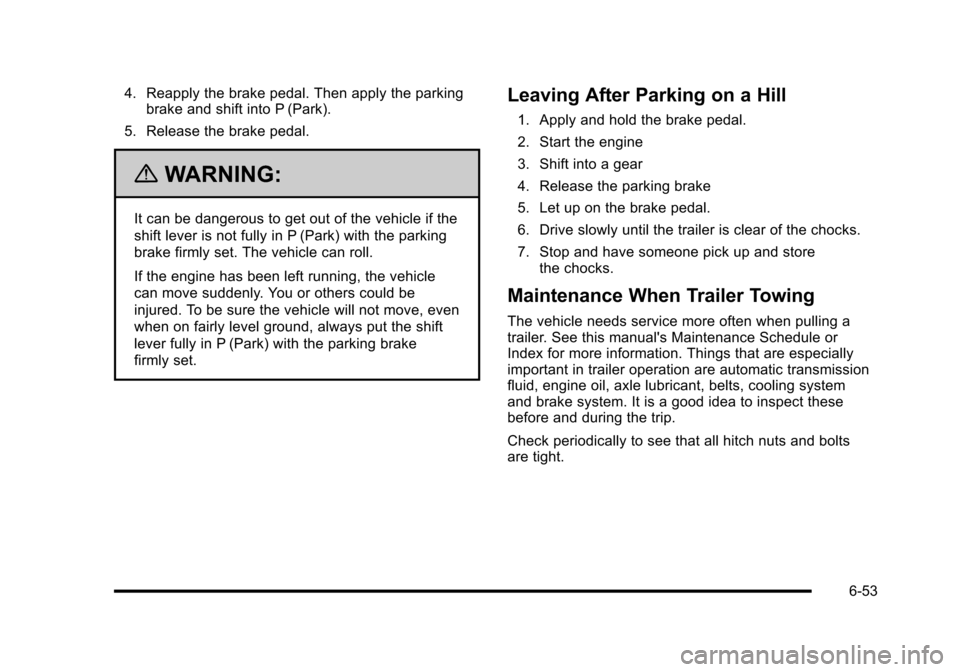
4. Reapply the brake pedal. Then apply the parkingbrake and shift into P (Park).
5. Release the brake pedal.
{WARNING:
It can be dangerous to get out of the vehicle if the
shift lever is not fully in P (Park) with the parking
brake firmly set. The vehicle can roll.
If the engine has been left running, the vehicle
can move suddenly. You or others could be
injured. To be sure the vehicle will not move, even
when on fairly level ground, always put the shift
lever fully in P (Park) with the parking brake
firmly set.
Leaving After Parking on a Hill
1. Apply and hold the brake pedal.
2. Start the engine
3. Shift into a gear
4. Release the parking brake
5. Let up on the brake pedal.
6. Drive slowly until the trailer is clear of the chocks.
7. Stop and have someone pick up and storethe chocks.
Maintenance When Trailer Towing
The vehicle needs service more often when pulling atrailer. See this manual's Maintenance Schedule orIndex for more information. Things that are especiallyimportant in trailer operation are automatic transmissionfluid, engine oil, axle lubricant, belts, cooling systemand brake system. It is a good idea to inspect thesebefore and during the trip.
Check periodically to see that all hitch nuts and boltsare tight.
6-53
Page 470 of 616
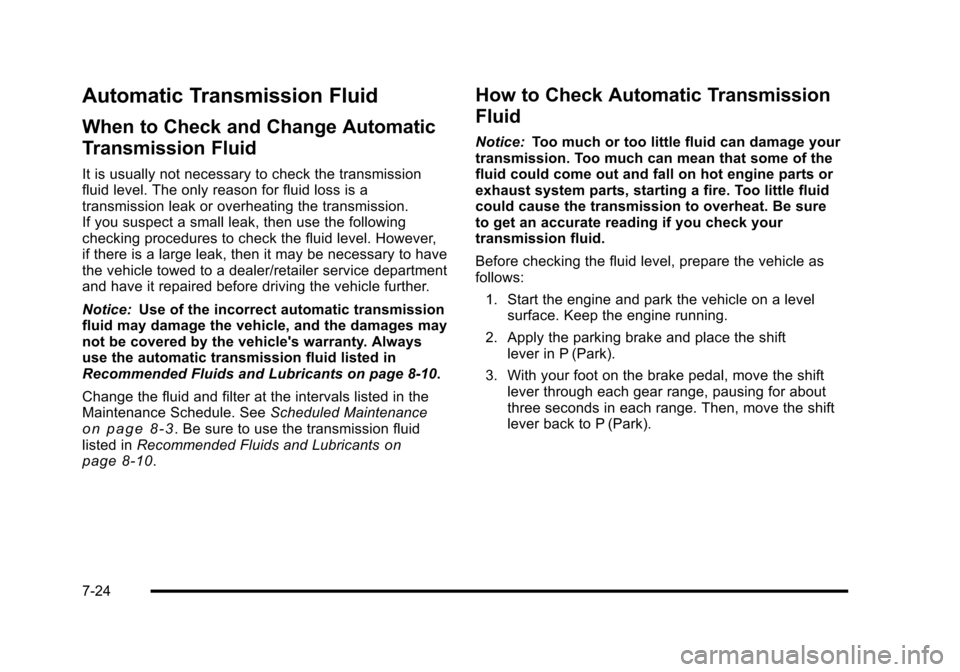
Automatic Transmission Fluid
When to Check and Change Automatic
Transmission Fluid
It is usually not necessary to check the transmissionfluid level. The only reason for fluid loss is atransmission leak or overheating the transmission.If you suspect a small leak, then use the followingchecking procedures to check the fluid level. However,if there is a large leak, then it may be necessary to havethe vehicle towed to a dealer/retailer service departmentand have it repaired before driving the vehicle further.
Notice:Use of the incorrect automatic transmissionfluid may damage the vehicle, and the damages maynot be covered by the vehicle's warranty. Alwaysuse the automatic transmission fluid listed inRecommended Fluids and Lubricants on page 8!10.
Change the fluid and filter at the intervals listed in theMaintenance Schedule. SeeScheduled Maintenanceo n p a g e 8!3. Be sure to use the transmission fluidlisted inRecommended Fluids and Lubricantsonpage 8!10.
How to Check Automatic Transmission
Fluid
Notice:Too much or too little fluid can damage yourtransmission. Too much can mean that some of thefluid could come out and fall on hot engine parts orexhaust system parts, starting a fire. Too little fluidcould cause the transmission to overheat. Be sureto get an accurate reading if you check yourtransmission fluid.
Before checking the fluid level, prepare the vehicle asfollows:
1. Start the engine and park the vehicle on a levelsurface. Keep the engine running.
2. Apply the parking brake and place the shiftlever in P (Park).
3. With your foot on the brake pedal, move the shiftlever through each gear range, pausing for aboutthree seconds in each range. Then, move the shiftlever back to P (Park).
7-24
Page 563 of 616

Section 8 Maintenance Schedule
Maintenance Schedule. . . . . . . . . . . . . . . . . . . . . . . . . . . . 8-2Introduction . . . . . . . . . . . . . . . . . . . . . . . . . . . . . . . . . . . . . 8-2Scheduled Maintenance . . . . . . . . . . . . . . . . . . . . . . . . 8-3Owner Checks and Services . . . . . . . . . . . . . . . . . . . . 8-8
Recommended Fluids and Lubricants . . . . . . . . . . 8-10Maintenance Replacement Parts . . . . . . . . . . . . . . 8-12Engine Drive Belt Routing . . . . . . . . . . . . . . . . . . . . . 8-13Maintenance Record . . . . . . . . . . . . . . . . . . . . . . . . . . . 8-14
8-1
Page 564 of 616
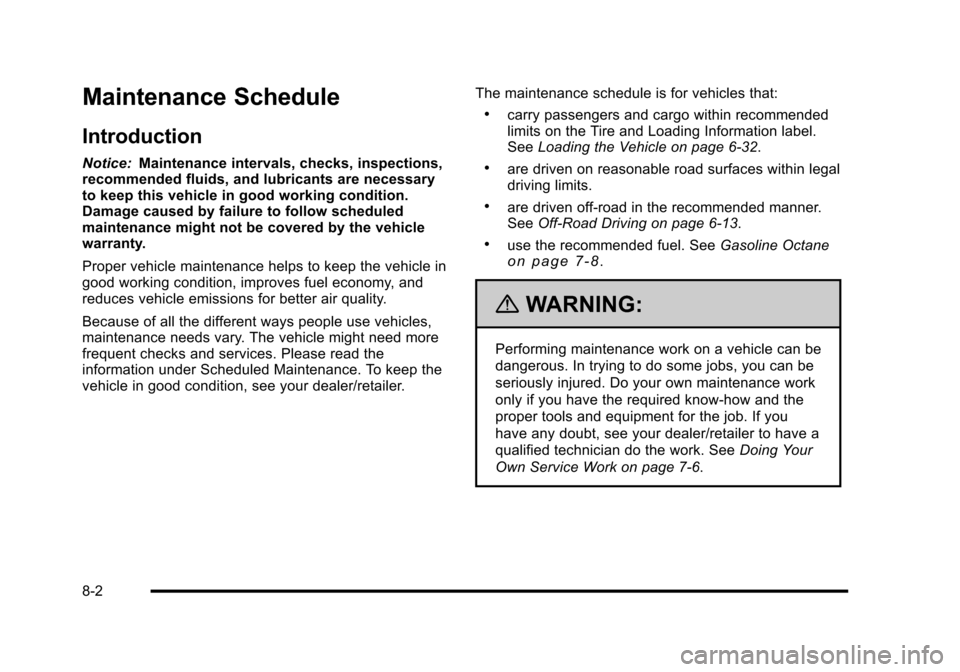
Maintenance Schedule
Introduction
Notice:Maintenance intervals, checks, inspections,recommended fluids, and lubricants are necessaryto keep this vehicle in good working condition.Damage caused by failure to follow scheduledmaintenance might not be covered by the vehiclewarranty.
Proper vehicle maintenance helps to keep the vehicle ingood working condition, improves fuel economy, andreduces vehicle emissions for better air quality.
Because of all the different ways people use vehicles,maintenance needs vary. The vehicle might need morefrequent checks and services. Please read theinformation under Scheduled Maintenance. To keep thevehicle in good condition, see your dealer/retailer.
The maintenance schedule is for vehicles that:
.carry passengers and cargo within recommendedlimits on the Tire and Loading Information label.SeeLoading the Vehicle on page 6!32.
.are driven on reasonable road surfaces within legaldriving limits.
.are driven off!road in the recommended manner.SeeOff-Road Driving on page 6!13.
.use the recommended fuel. SeeGasoline Octaneo n p a g e 7!8.
{WARNING:
Performing maintenance work on a vehicle can be
dangerous. In trying to do some jobs, you can be
seriously injured. Do your own maintenance work
only if you have the required know-how and the
proper tools and equipment for the job. If you
have any doubt, see your dealer/retailer to have a
qualified technician do the work. SeeDoing Your
Own Service Work on page 7!6.
8-2
Page 565 of 616

At your General Motors dealer/retailer, you can becertain that you will receive the highest level of serviceavailable. Your dealer/retailer has specially trainedservice technicians, uses genuine GM replacementparts, as well as, up to date tools and equipment toensure fast and accurate diagnostics.
The proper replacement parts, fluids, and lubricants touse are listed inRecommended Fluids and Lubricantson page 8!10andMaintenance Replacement Partsonpage 8!12. We recommend the use of genuine partsfrom your dealer/retailer.
Rotation of New Tires
To maintain ride, handling, and performance of thevehicle, it is important that the first rotation service fornew tires be performed when they have 8 000 to13 000 km (5,000 to 8,000 miles). SeeTire Inspectionand Rotation on page 7!71.
Scheduled Maintenance
When the Change Engine Oil Soon
Message Displays
Change engine oil and filter. SeeEngine Oilonpage 7!17.An Emission Control Service.
When the Change Engine Oil Soon message displays,service is required for the vehicle as soon as possible,within the next 1 000 km/600 miles. If driving under thebest conditions, the engine oil life system might notindicate the need for vehicle service for more than ayear. The engine oil and filter must be changed at leastonce a year and the oil life system must be reset. Yourdealer/retailer has trained service technicians who willperform this work and reset the system. If the engine oillife system is reset accidentally, service the vehiclewithin 5 000 km/3,000 miles since the last service. Resetthe oil life system whenever the oil is changed. SeeEngine Oil Life System on page 7!20.
When the Change Engine Oil Soon message displays,certain services, checks, and inspections are required.
8-3